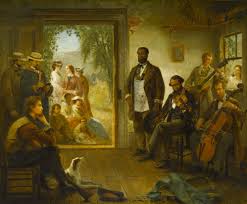Annotation:Yellow Barber
X:1 T:Yellow Barber M:2/4 L:1/8 S:Gerry Milnes Z:AK/Fiddler’s Companion K:D A,/B,/D/E/ DD/D/|A,/B,/D/E/ F/E/D|C/D/E E>(A,/2B,/4|C)E G/F/E|! E/F/A AA/A/|B/A/F/G/ A g/f/|(3f/g/f/e (3d/e/d/B|A/F/E/F/ D2:|! |:(A<d) d>B|Ad/e/ f/e/d|c/d/e/f/ ee/d/|ce/f/ g/f/e|! f/a/f/f/ e/d/B/d/|B/A/F/G/ AA/A/|((3f/g/f/e) ((3d/e/d/B)|A/F/E/F/ D2:|!
YELLOW BARBER. AKA and see "Arthur Berry." Old Time, Breakdown. USA; Kentucky, West Virginia, southern Ohio. D Major. Standard tuning (fiddle). AB (Silberberg, Titon): AABB (Phillips). Although the name Yellow Barber is given to a bird species, the general consensus seems to be that the title refers to a mulatto barber, a common-enough occurrence among freemen in the South as well as other parts of the country. It appears to have also been fairly common for fiddlers and other musicians to moonlight as barbers (or vice versa). John Heine has found a reference to a mulatto barber named William B. Taylor, a fiddler born in Kentucky in 1821, who called the figures as he played. Taylor's Band --composed of barbers -- played for hundreds of balls, banquets and steamboat excursions in the Minnesota territory from 1849 until his death in 1862. Taylor called figures while he played and is was remembered as having "a voice a brigadier general might envy.” Heine finds reference to African-Americans and barbering in a Saint Paul paper that commented in 1852:
In the first place, our Blacks are attentive to their business, and are no fiddlers, as they are represented to be, in the slave States. Secondly, they are a useful class, and here on the confines of Barbarism do as much to put a civilized aspect upon the face of society as any other class. Their barber shops are favorite places of resort for many bachelor Whites who meet there, as on a social exchange. Thirdly, the Blacks are our musicians. A Negro’s music always has a charm for every ear -- whether it is the music of the rosin and the bow, or the guitar, or the soft lubly voice, each separately or all combined, as of a stilly night, in a serenade.
Another reference to Taylor can be found in the memoirs of Marian Furness Ramsey, daughter of Governor Alexander Ramsey, who remembered a banquet her father gave for the state legislature (in 1861 or 1862):

But, of course, what fascinated me was the dancing in the parlor. The mazurka, the schottische, and the polka were the fashion. Square dances alternated with round, a cotillion, or the lanciers; and Bill Taylor, the fashionable colored barber, played the violin in the small orchestra, at the same time calling out the figures in stentorian tones.
East Kentucky fiddler Buddy Thomas, who lived near Portsmouth, recorded an influential version of this square dance tune before he died at age 39 in 1974. Mark Wilson remarks that fiddlers east of Portsmouth, Ohio, often called the tune “Arthur Berry.” The tune was also in the repertoire of Portsmouth, Ohio, fiddler and instrument repairer Jimmy Wheeler (1917-1987), who learned it either from his father or Acey "Aaa" Neal. Jeff Goehring says it was one of the "not-strictly Kentucky" tunes "popular among Portsmouth area fiddlers of an earlier era" [1]. Gerry Milnes says “Yellow Barber” is well-known in the tri-state area around Huntington, Ashland and Ironton. Jeff Titon (2001) believes Indiana fiddler John W. Summers probably learned it from Kentucky fiddler Tom Riley, who was originally from Bath County, where the tune is better known under the “Arthur Barrie” title.

